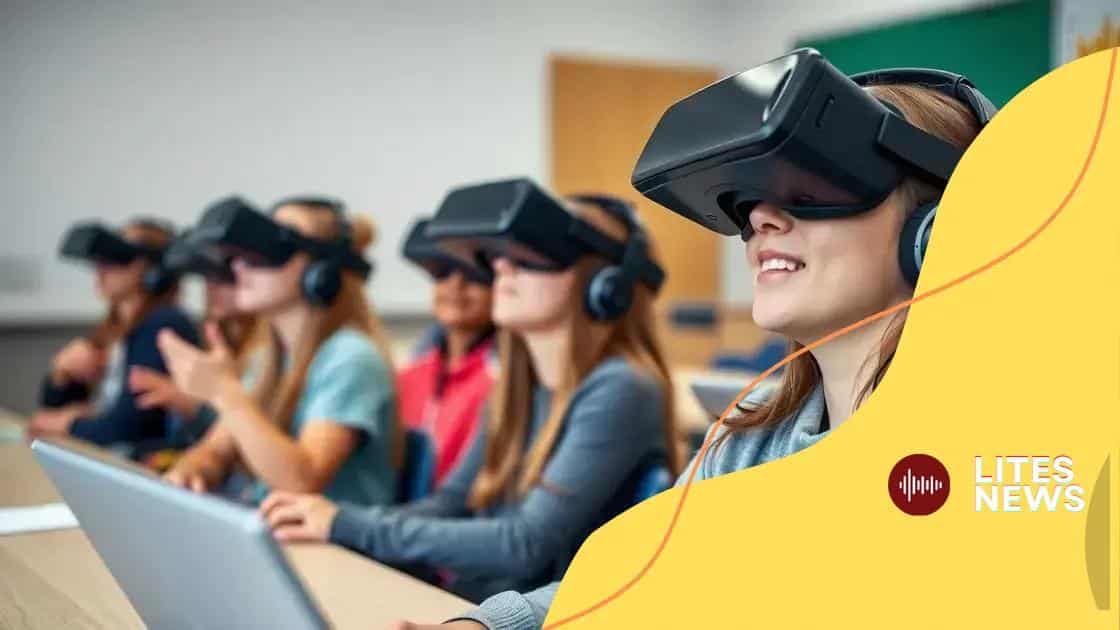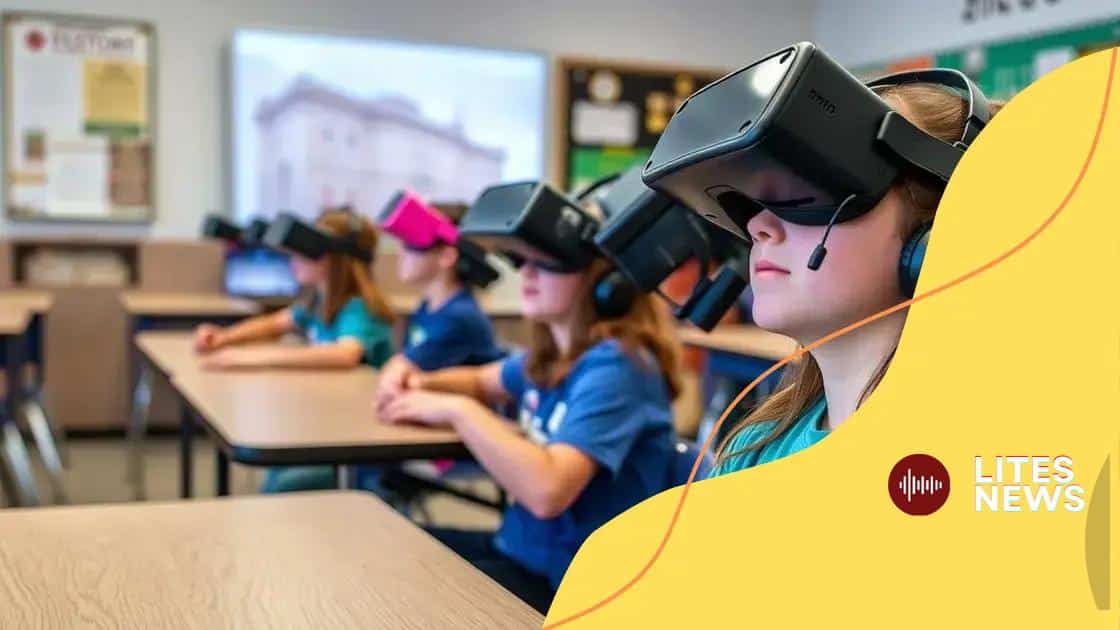Virtual reality revolutionizing education: a new learning frontier

Virtual reality is revolutionizing education by providing immersive experiences that enhance engagement, enable personalized learning, and facilitate global collaboration among students, despite challenges like cost and accessibility.
Virtual reality revolutionizing education is not just a trend; it’s a transformative force reshaping how we learn. Imagine stepping into a historical event or exploring the cosmos from your classroom. Intrigued? Let’s delve into this exciting topic.
Understanding virtual reality in education
Understanding virtual reality in education is essential as its integration becomes more widespread. It allows students to immerse themselves in interactive environments, enhancing their learning experience.
What is Virtual Reality?
Virtual reality (VR) is a technology that creates a simulated environment, enabling users to interact with 3D worlds using specialized equipment, like headsets. This technology can transform traditional educational settings.
Benefits of VR in Learning
- Engagement: VR captivates students’ attention by providing immersive experiences.
- Realism: Students can experience scenarios that may not be possible in real life, like visiting ancient civilizations.
- Collaboration: VR allows students to work together in virtual spaces, fostering teamwork and communication.
By using VR technology, educators can create dynamic lessons that resonate with students. Imagine exploring the depths of the ocean or traveling through time while learning. Such experiences deepen understanding and retention.
Furthermore, virtual reality caters to various learning styles. Visual learners benefit from seeing, auditory learners from hearing, and kinesthetic learners from touching the virtual interfaces. Each student can interact with the content in ways that suit their personal learning preferences, making education more tailored.
Challenges in Implementing VR
Although the advantages are clear, implementing virtual reality in education does have challenges. Cost can be a significant factor for schools, as high-quality equipment can be expensive. Additionally, educators need training to effectively use VR tools to maximize their benefits.
Despite these hurdles, understanding virtual reality in education is crucial as it opens up new frontiers for teaching and learning. By embracing this technology, educational institutions can prepare students for a future where digital and physical worlds intertwine.
Benefits of virtual reality for students
The benefits of virtual reality for students are transforming how education is delivered. With immersive technology, learning becomes more engaging and effective.
Enhanced Learning Experience
Virtual reality offers an experience like no other. Instead of just reading about historical events, students can step into them. This unique method captivates their attention and allows for a deeper understanding of the content.
Improved Retention
Studies show that students remember information better when they experience it firsthand. The immersive nature of VR helps solidify knowledge, making lessons unforgettable.
- Active Participation: Students who participate actively in their learning tend to remember more.
- Visual Learning: Those who learn better through visuals benefit greatly from 3D environments.
- Real-World Applications: VR can simulate real-world situations, providing practical skills.
Additionally, many students have different learning styles. Some may grasp concepts quickly through visuals, while others benefit from hands-on experiences. Virtual reality ensures that there are options for everyone.
Collaboration and Social Skills
Another significant benefit is the opportunity for collaboration. When students use VR, they often work together in virtual settings. This experience encourages teamwork and improves social skills.
Moreover, VR technology breaks down geographical barriers. Students from different parts of the world can participate in the same virtual classroom, sharing experiences and knowledge.
As we explore the advantages of virtual reality in education, it becomes clear that it enhances engagement, retention, and collaboration among students.
Real-world applications of VR in classrooms

Real-world applications of VR in classrooms provide an exciting glimpse into the future of education. With technology advancing, teachers can use virtual reality to create engaging and interactive lessons that resonate with students.
Science Experiments
One of the most impactful uses of VR is in science education. Students can conduct virtual experiments that may be too dangerous or impractical to perform in a traditional lab setting. Imagine exploring the human body in 3D anatomy classes or observing chemical reactions safely in a virtual lab.
Field Trips
Virtual reality also allows for immersive field trips without leaving the classroom. Students can visit historical sites, national parks, or even outer space. This method makes learning about different cultures and environments more tangible and accessible.
- Visit Ancient Civilizations: Walk through the streets of ancient Rome or explore the pyramids of Egypt.
- Underwater Exploration: Dive into the ocean to study marine life firsthand.
- Space Adventures: Experience a simulated journey to Mars or the Moon.
Using VR technology in classrooms fosters a sense of exploration and curiosity. Students engage more deeply with content when they can visualize and simulate scenarios. This hands-on approach caters to various learning styles, ensuring that everyone benefits from the experience.
Skills Training
Another crucial application of virtual reality is in vocational training. Programs can teach essential skills in fields such as medicine, engineering, and performing arts. For instance, nursing students can practice patient care in a controlled environment, gaining confidence and experience.
Furthermore, VR allows for real-time feedback, helping students improve their skills as they practice. This immediate assessment helps tailor the learning experience to individual needs.
As we see the real-world applications of VR in classrooms, it’s clear that this technology not only enhances education but also prepares students for future challenges by providing them with practical experience in a safe, immersive way.
Challenges of integrating virtual reality in learning
Integrating virtual reality in learning comes with its own set of challenges. While the benefits are clear, the obstacles must also be considered to make VR a successful educational tool.
Cost of Implementation
One of the biggest hurdles is the cost associated with VR technology. High-quality headsets and software can be expensive, making it difficult for some schools to justify the investment. Additionally, budget constraints can limit access to the latest technology, leaving some students behind.
Training for Educators
Another prominent issue is the need for teacher training. Educators must be comfortable using VR tools to effectively integrate them into their lessons. Without proper training, teachers may struggle to implement these technologies and fail to utilize their full potential.
- Need for Professional Development: Instructors require ongoing training to adapt to new technologies.
- Time Constraints: Teachers already have busy schedules, which can make finding time for training difficult.
- Tech Support: Ongoing technical support is necessary to resolve issues as they arise.
Compatibility with existing curriculum poses another challenge. Virtual reality lessons must align with educational standards and learning goals. This alignment can be difficult as educators attempt to design lessons that incorporate VR without losing sight of traditional learning objectives.
Accessibility Issues
Moreover, accessibility is a major factor. Not all students may have the same ability to use VR technology effectively. Some may experience motion sickness or have physical limitations that prevent meaningful participation. Schools must consider these factors to ensure that all students can benefit from VR experiences.
The complexity of creating quality content for virtual reality in education cannot be overlooked. Developing engaging, high-quality VR experiences takes time and expertise, which can be a barrier for many educators.
Although integrating virtual reality in learning presents challenges, understanding and addressing these obstacles can pave the way for more innovative and effective educational experiences.
The future of education with virtual reality
The future of education with virtual reality holds immense possibilities. As technology continues to evolve, VR will likely play a central role in shaping how students learn and interact with educational content.
Personalized Learning
One of the most promising aspects is the potential for personalized learning experiences. With VR technology, lessons can be tailored to meet the unique needs of each student. This means that learners can progress at their own pace, engaging with material in ways that suit their learning style.
Global Classrooms
Another exciting advantage is the ability to create global classrooms. Students from different countries can join the same virtual environment, participating in collaborative projects and cultural exchanges. This fosters a sense of community and prepares students for a globalized world.
- Diverse Perspectives: Learners can understand different cultures better by interacting with peers around the world.
- Shared Experiences: Virtual exchanges enhance learning by allowing students to experience lessons together.
- Collaborative Problem Solving: Group tasks in VR can strengthen teamwork and communication skills.
In addition to collaborative efforts, VR education can enhance engagement. Traditional lectures may fade in popularity as immersive, interactive lessons become the norm. Imagine a history class where students can “walk” through ancient cities or a science lesson that takes them on a journey through the human body.
Skills Development
Moreover, the focus on skills development will grow in importance. Schools and educators can use VR technology to prepare students for the workforce by providing them with practical experiences. This valuable hands-on training can occur in various fields, from medicine to engineering.
As educators embrace these innovations, they must also consider the ethical implications of VR in education. Ensuring that all students have access to this technology will be essential in creating equitable learning opportunities.
Ultimately, the future of education with virtual reality is bright. It promises to make learning more engaging, interactive, and globally connected. As we move forward, embracing these advancements can unlock new potential for the next generation of learners.
In conclusion, the use of virtual reality in education opens up exciting possibilities for students and teachers alike. As we embrace this technology, we must focus on creating an inclusive and engaging learning environment. With the potential for personalized learning, global collaboration, and practical skills development, VR is set to transform education for the better. By addressing the challenges, we can ensure that all students benefit from these innovative learning experiences.
FAQ – Frequently Asked Questions about Virtual Reality in Education
How does virtual reality enhance the learning experience?
Virtual reality provides immersive experiences, allowing students to interact with content in a dynamic way, which can improve engagement and understanding.
What are the main benefits of using VR in classrooms?
The main benefits include personalized learning, global collaboration with peers, and practical skills development through hands-on experiences.
What challenges do schools face when integrating VR?
Challenges include high costs of equipment, the need for teacher training, and ensuring that the technology aligns with existing curricula.
Is virtual reality accessible to all students?
While VR has great potential, accessibility can be an issue. Schools must ensure that every student can benefit from these experiences, regardless of their circumstances.





